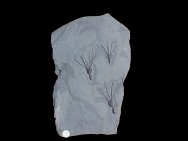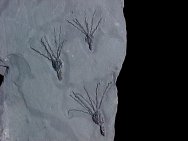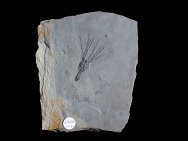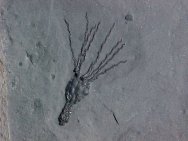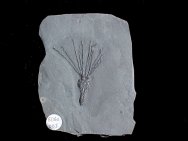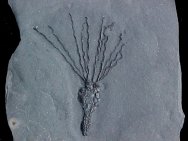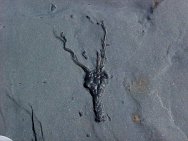Gogia
spiralis
Phylum Echinodermata, Subphylum Blastozoa, Class Eocrinoidea (also
called Dawn Crinoid, or Eocrinoid)
Geologic Age: Middle Cambrian
Fossil Site: Upper Wheeler Formation, Millard County, Utah
The genus
Gogia represents one of the most primitive groups of stalked
echinoderms, hence the class assignment Eocrinoidea, which roughly
means “dawn crinoid”. Echinoderms include groups as
diverse as starfish, sea urchins, crinoids, and sand dollars.
Gogia differed from true crinoids in that they had pores along
the margins separating the plates, and the type of feeding arms
they displayed. The species Gogia spiralis derives its name from
its tightly spiraled arms and is only one of three Gogia species
to have spiraled arms. Gogia had a vase-shaped body or calyx with
irregularly positioned plates. It also had a stalk made up of
smaller plates that attached to the sea floor, and food-gathering
arm-like structures called brachioles. Gogia was a sessile (stationary)
suspension feeder gathering food with its arms in calm waters
of shallow Cambrian seas. Gogia spiralis usually attached directly
to the mud, but on rare occasions attached to brachiopods and
trilobite fragments on the sea floor. Gogia were widely distributed
in the lower and middle Cambrian formations of western North America,
but only a few partial specimens have been found in the Burgess
Shale. Gogia occurred at the base of the cystoid radiation, with
three distinct cystoid lineages derived from different Gogia species.
Gogia lived only during the Cambrian time period, but the cystoids
that evolved from them survived until the end of the Devonian.
|
click images
to enlarge
|
|
|
|
35mm,
35mm, 27mm, on 135mm X 90mm matrix
Code EDGO-001 - Sold |
34mm
on 80mm X 65mm matrix
Code EDGO-002 - Sold |
|
|
|
|
|
35mm
on 65mm X 50mm matrix
Code EDGO-003 - Sold |
19mm
on 40mm X 43mm matrix
Code EDGO-004 - Sold
|
|

